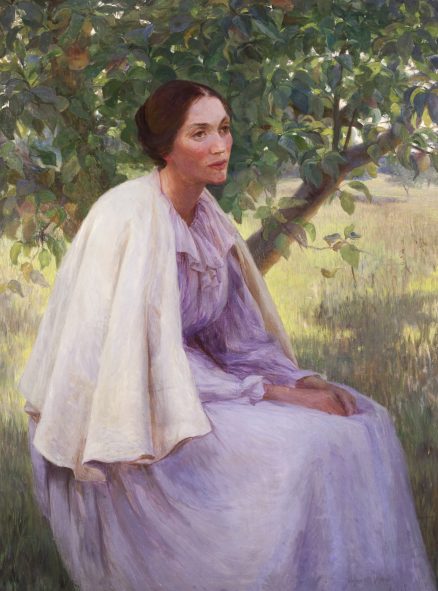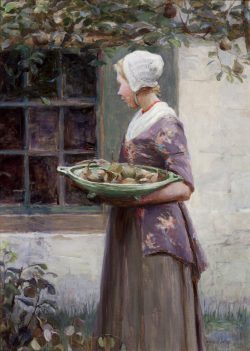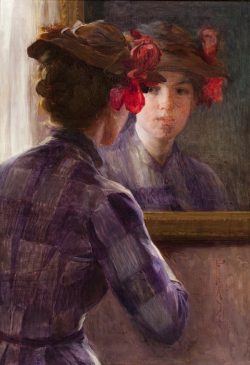The Seeker: I Sent My Soul through the Invisible
, dated 1897Oil on canvas, 48 by 36 inches
- Categories
- Figural works
- Women
- Women artists
- Zoom in on Artwork
- Print Page
- Email Page to Friend
The Seeker is perhaps the most ambitious easel painting of Pauline Dohn’s relatively brief career. This image of a young woman caught in a moment of serious reverie is set outdoors, beneath the boughs of a pear tree whose fruitfulness echoes her own ripening womanhood. She gazes into the distance, evidently unaware either of the viewer or of the surrounding landscape. Both the painting’s title and the quotation often appended to it, a fragment of a verse from Rubaiyat of Omar Khayyám by Edward FitzGerald, allude to the woman’s spiritual quest:
I sent my soul through the invisible,
some letter of that afterlife to spell;
and by and by my soul returned to me,
and answered, “I myself am Heav’n and Hell.”
Dohn painted The Seeker in Chicago shortly after returning from a productive stay in Europe, including a summer in rural Holland with American artists Gari Melchers and George Hitchcock, who specialized in painting local peasant life. Both The Seeker and Dohn’s Pear Time also reveal the influence of French painter Jules Bastien-Lepage, notably in the cool tones of the leaves that crowd close to the picture plane to form a decorative patterned screen. Bastien-Lepage was one of many European artists of the time whose paintings explore the idea of inner sight. Late-nineteenth-century fascination with dream visions and the metaphysical was also manifested in numerous translations of Rubaiyat: three separate versions appeared between 1889 and 1898, and in 1899 the Caxton Club of Chicago published a list of the many translations. Although Dohn’s image makes no reference to the medieval Persian context of her literary inspiration, she drew on its contemporary popularity for her image, which juxtaposes hyperreal materiality with the suggestion of “the invisible.”
In the two years after she completed The Seeker, Dohn exhibited the painting widely, sending it to prestigious annual exhibitions in Pittsburgh, Philadelphia, New York, Cincinnati, and Boston before it appeared in the Art Institute of Chicago’s 1899 annual show of work by Chicago artists, where it received “a position of honor” and abundant attention from reviewers.i One of them called Dohn’s painting “perhaps the most pretentious” of the “many pictures on the walls that redound to her artistic credit”—among which was also A Village Belle. The seriousness and sincerity of The Seeker provoked an unidentified member of the bohemian Palette and Chisel Club to paint “The Sinker,” a parody of Dohn’s masterpiece, for display in the prankish “Salon de Refuse” show organized by the club to coincide with the Art Institute’s exhibition.
Wendy Greenhouse, PhD
Donated by M. Christine Schwartz to the Winnetka Historical Society, Winnetka, Illinois, in 2021
i “Art,” Chicago Times Herald, Feb. 26, 1899.


